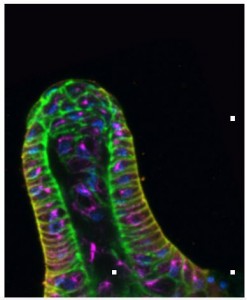
Confocal micrograph of the tip of a Dictyostelium discoideum fruiting body, stained for DNA (blue), actin (green), Ddα-catenin (orange) and tubulin (magenta). Image: Daniel J. Dickinson, Program in Cancer Biology, Stanford University Read more: Unexpected slime mold complexity - The Scientist - Magazine of the Life Sciences http://www.the-scientist.com/news/display/58047/#ixzz1GJv3BSEQ
Ed. for the non biologist … one of the REAL missing links is understanding how single cells come together to form a multicellular organisms …
from The Scientist:
The results, published this week in Science, add to a growing body of evidence that the genetic toolkit for multicellularity existed well before complex organisms became commonplace on the planet.
…When food reserves run low, the slime mold Dictyostelium discoideum morphs into a multicellular fruiting body with a stiff stalk structure that harbors spores capable of floating to more bountiful environments. A ring of cells sits atop the stalk, and is suspected to contribute to the stalk’s formation, but the molecular structure and function of those cells have not been studied in detail until now.
Daniel Dickinson, a Stanford University PhD candidate and first author of the study, became interested in these slime molds when he discovered that they contained a protein similar to α-catenin, a key component of cell polarization in metazoans (animals). “People think of this protein as having a central role in animal development and in cell-cell adhesion.” Dickinson said. “So it certainly provoked my interest that there would be homologs outside of animals.”
Examining the tip cells, Dickinson and his colleagues saw that they had a distinct polarization, with certain organelles concentrated on one side, much like metazoan epithelial cells. Dicty‘s version of α-catenin — dubbed Ddα-catenin — played a role in the polarization process, as did another Dicty protein called Aardvark, a homolog of the metazoan β-catenin. In Aardvark knockout strains and in slime molds in which Ddα-catenin was depleted using RNA interference, the fruiting body failed to mature and the tip cells never formed a polarized epithelium. Further tests suggested that these defects resulted from the tip epithelial cells’ failure to secrete the cellulose and extracellular matrix proteins necessary for stalk formation.
“We found that this protein in Dicty really functions like α-catenin [in animals],” Dickinson said — it is required for cell polarization, which facilitates the directional absorption and secretion of materials.
“This shows that two groups of organisms that independently evolved multicellularity both used [the same] off-the-shelf tools for polarizing tissues,” Dunn added. “This drives home the notion that new genes are not needed for new organism features; existing genes can be used in new ways.”
To read about other example of non-metazoan organisms utilizing genes once believed to be unique to animals, check out The Scientist‘s recent feature on the evolution of multicellularity.
D. Dickinson, et al., ” A polarized epithelium organized by β- and α-catenin predates cadherin and metazoan origins,” Science, 331: 1336-39, 2011.